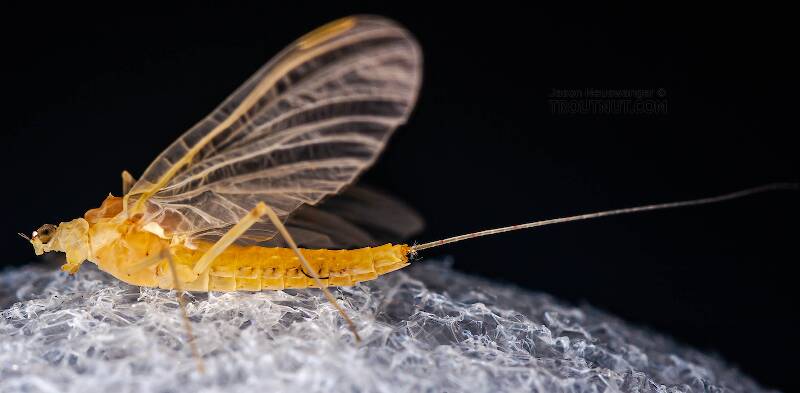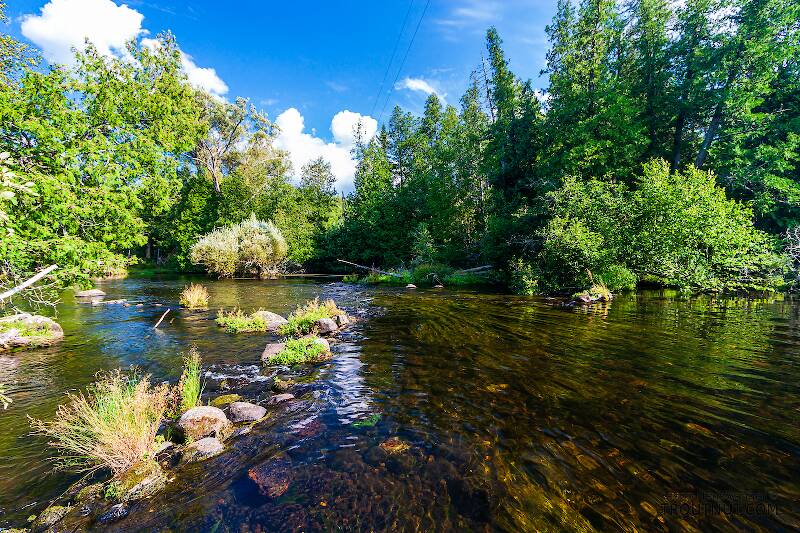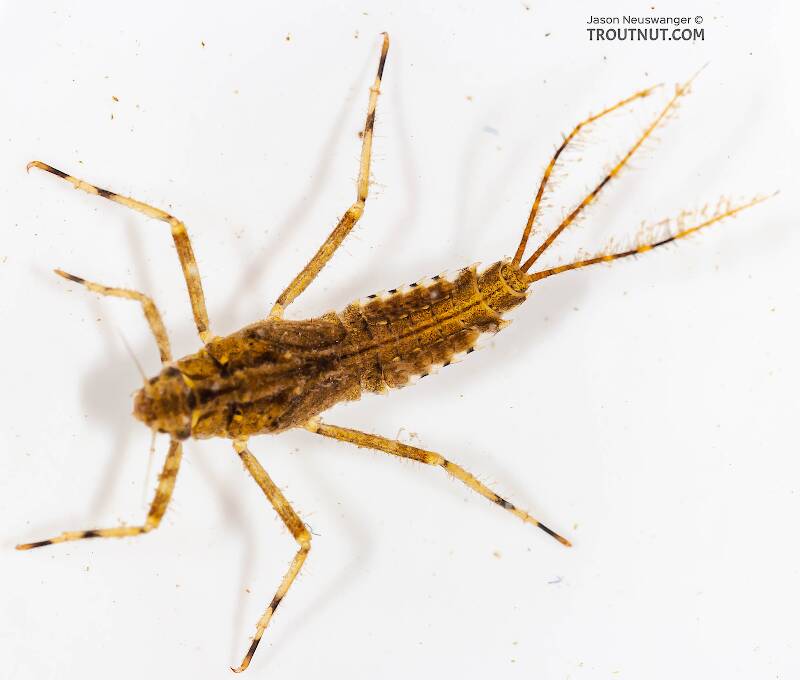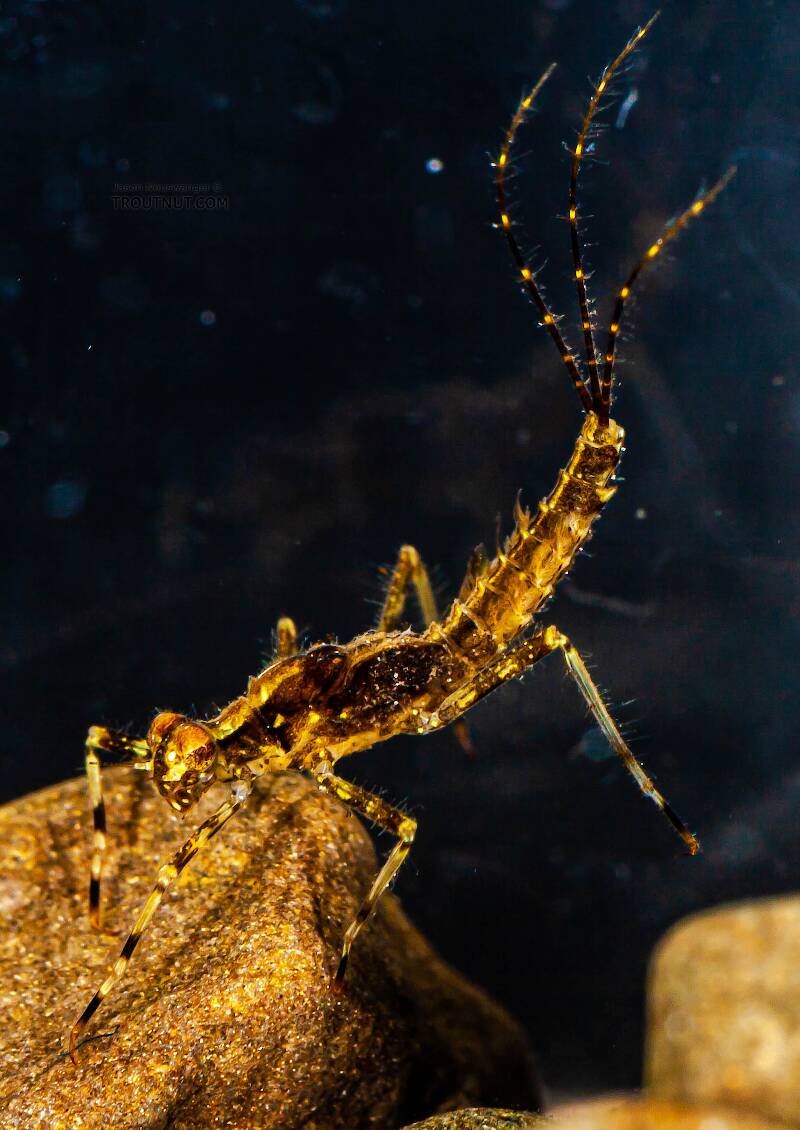
Hex Mayflies
Hexagenia limbata
The famous nocturnal Hex hatch of the Midwest (and a few other lucky locations) stirs to the surface mythically large brown trout that only touch streamers for the rest of the year.


Mayfly Species Penelomax septentrionalis
This species was overlooked in the fly-fishing literature for many years. The first details appear in Fly-Fishing Pressured Water, which states that this species (formerly called Ephemerella septentrionalis) sometimes supports hatches of Ephemerella invaria. Ernest Schwiebert's Nymphs Volume I: The Mayflies: The Major Species seconds that claim, suggesting that it generates fishable hatches which may go unnoticed due to confusion with both Ephemerella invaria and Ephemerella dorothea. However, the long legs, thin dorsal stripe, and more vivid color make it easy to tell them apart upon close inspection.
Where & when
There are records of this species from Tennessee north into Ontario and Quebec. They begin in early May near the southern end of their range, and continue into midsummer in Canada. Expect them from mid-May through early June in the popular fly fishing waters of Pennsylvania and New York, from the limestone spring creeks to the freestone Catskill and Poconos waters. Their timing coincides with the more common and similar Ephemerella invaria.In 19 records from GBIF, adults of this species have been collected during June (74%), July (16%), May (5%), and November (5%).
In 4 records from GBIF, this species has been collected at elevations of 341, 361, 2152, and 2441 ft.
Species Range
Spinner behavior
Time of day: Twilight
Nymph biology
Substrate: Weedy stretches of stream
Physical description
Most physical descriptions on Troutnut are direct or slightly edited quotes from the original scientific sources describing or updating the species, although there may be errors in copying them to this website. Such descriptions aren't always definitive, because species often turn out to be more variable than the original describers observed. In some cases, only a single specimen was described! However, they are useful starting points.
Male Spinner
Wing length: 9 mm
A species of the Ephemerella needhami group; femora and tibiae of imago very long as compared with tarsi.
Head brownish; eyes light orange-red. Thorax yellowish to olive brown dorsally; ventrally pale yellowish with reddish tinges; pleura yellow, tinged with ruddy. Legs very long; femur and tarsus of hind leg subequal in length, each being more than twice as long as the tarsus. Pale yellowish, the femora brownish at the apex. Wings hyaline, venation entirely colorless. Abdominal tergites 1-7 dull olive to smoky brown; traces of black lateral dashes often present; posterior margins narrowly darker. Tergites 8-10 bright brown with a reddish tinge. Sternites pale yellowish, hyaline except the apical segments, which are opaque and somewhat darker. An interrupted median brownish stripe may be present, sometimes extending forward on to the thoracic sternum; four dark dots on each sternite, arranged in a curving line. A small dark spot may be present at the middle of the posterior margin.
Tails yellowish white, joinings rather faintly reddish brown. Second joint of forceps somewhat swollen on the inner apical margin. Penes separated apically by a deep rounded notch; several short spines on the margin of this notch, and on each side a larger toothlike process which projects into the notch (see fig. 155).
Nymph
The yellowish brown nymph is remarkable for the extreme length and slenderness of the legs, which are fringed with rather long hairs. Body yellowish, thickly sprinkled with very small brown dots. Head smooth; a tuft of hairs on each side of the occiput. Thorax smooth. Head shaded with brown along the median line; prothorax pale on median line, which is bounded on each side by a dark brown stripe. Legs yellowish; femora with three bands of dark brown; tibiae and tarsi banded near the middle, this band often lacking on the hind tibia. 11 to 12 denticles on the inner margin of each claw. Lateral extensions present on the abdominal segments; each bears a posterolateral spine. Gills present on segments 3-7. No dorsal spines, but the posterior margin is produced backward at the median line. A narrow brown median stripe the length of the dorsum, and traces of pale lateral stripes. Ventral markings consist of two dark oblique dashes on the anterior margin, and two small dark dots nearer the center of each sternite. Tails light brown at base, yellow apically; in the middle area, alternately banded with black and yellow. A whorl of spines at each joining, in the basal portion; apically without these spines, and margined with longer hairs.
Specimens of the Mayfly Species Penelomax septentrionalis
1 Female Dun

This really pretty mayfly was in kind of bad shape when I found it crippled on the surface, and bouncing around in my container with a bunch of green drakes didn't help.
2 Nymphs
Discussions of Penelomax septentrionalis
Start a Discussion of Penelomax septentrionalis
References
- Gonzales, Lloyd. 2005. Fly-Fishing Pressured Water. Stackpole Books.
- Needham, James G., Jay R. Traver, and Yin-Chi Hsu. 1935. The Biology of Mayflies. Comstock Publishing Company, Inc.
- Schwiebert, Ernest G. 2007. Nymphs Volume I: The Mayflies: The Major Species. The Lyons Press.
Mayfly Species Penelomax septentrionalis
Species Range
Resources
- NatureServe
- Integrated Taxonomic Information System
- Global Biodiversity Information Facility
- Described by McDunnough (1925)



